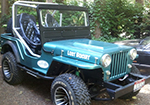Yesterday I made a first pass at a design for the gauges on the dashboard. As a part of that exercise, I tried to find a space for the data plate I have. The data plate is original to the CJ-3A I have and in good shape, except that it is faded, so it is hard to read. In fact, I tried to scan it into my scanner and the scanner couldn't pick up the words or pictures at all. After pondering the situation, I decided to recreate a data plate graphic and take it into a print shop to see if I can make a raise print or sticker of some kind. As part of the customization, I've tried to recreate the fonts as closely as possible, however, much to my surprise, the data plate uses several different fonts, some of which are the same font but stretched or bolded or both. Also, I've updated the data plate to better reflect the drive train I have installed.
Here's the current favorite mockup so far (note the font kerning and arrangement will be more precise on the final high resolution version).


Ok…..Now I’m curious about your t-case shift pattern……How is it that the left stick controls the rear axle and the right stick controls the front axle with the configuration you have?
The left shifter slides the rear sliding gear into high range, neutral, and low range. Remember, this is a Dana 20, so the rear sliding gear rides on the output shaft that is behind the transmission output shaft.
The right shifter controls the front sliding gear. This means the shifter slides the gear from high range, to neutral to low range. In a Dana 18, this wouldn’t work because you have the rear output behind the front output shaft.
I’ll create a pic and post it ..
Thanks,
– Dave
Just for clarification, I do say rear / front axles on my data plate, but what I mean is the OUTPUT to the rear and front differentials.
– Dave
Pingback: How the transfercase shifting works at eWillys